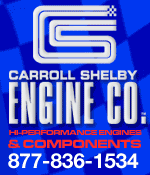 
 Main Menu
Main Menu
|
 Nevada Classics
Nevada Classics
|
 Advertise at CC
Advertise at CC
|
 April 2025
April 2025
|
| S |
M |
T |
W |
T |
F |
S |
| |
|
1 |
2 |
3 |
4 |
5 |
| 6 |
7 |
8 |
9 |
10 |
11 |
12 |
| 13 |
14 |
15 |
16 |
17 |
18 |
19 |
| 20 |
21 |
22 |
23 |
24 |
25 |
26 |
| 27 |
28 |
29 |
30 |
|
|
|
|
 CC Advertisers
CC Advertisers
|
|

12-04-2013, 01:45 PM
|
|
CC Member

|
|
|
Join Date: May 2012
Location: sandusky,
oh
Cobra Make, Engine: A&C 427 s/o
Posts: 81
|
|

 Not Ranked
Not Ranked
 comp. ratio 427
comp. ratio 427
Does anybody know how to figure out what your comp. ratio will be when the manufacture dosen't list your combustion chamber size. It says 73cc 11:4:1,
76cc 11:0:1 dome volume -8cc, but i would like to know what it would be for 88cc chambers. I also would like to know what the limit is for comp. ratio (streetable) with cast iron heads using pump gas. thanks
Last edited by cobrabritt83; 12-04-2013 at 01:52 PM..
|
-
Advertising


12-04-2013, 02:40 PM
|
 |
CC Member

|
|
|
Join Date: Jan 2008
Location: Williamsport,
PA
Cobra Make, Engine: Kellison Stallion 468 FE
Posts: 2,703
|
|

 Not Ranked
Not Ranked
Quote:
Originally Posted by cobrabritt83

Does anybody know how to figure out what your comp. ratio will be when the manufacture dosen't list your combustion chamber size. It says 73cc 11:4:1,
76cc 11:0:1 dome volume -8cc, but i would like to know what it would be for 88cc chambers. I also would like to know what the limit is for comp. ratio (streetable) with cast iron heads using pump gas. thanks
|
i don't like to exceed 10:1 with iron and 93 octane. others may have a different preference.
i'm not sure but last motor i remember doing i think it was 10cc=1 pt CR
so the info you were showing the 88cc would be about 10 CR...i think... the -8cc is a dished piston...
if your buying pistons provide the CC of the head, deck height, the rod length and state what CR you want and they will make them for you
__________________
Fred B
|

12-04-2013, 03:41 PM
|
 |
CC Member

|
|
|
Join Date: Apr 2009
Location: Little Rock area,
AR
Cobra Make, Engine: ERA Street Roadster #782 with 459 cu in FE KC engine, toploader, 3.31
Posts: 4,532
|
|

 Not Ranked
Not Ranked
You can take this for what it's worth - but I could not talk Keith Craft into going above 9:1 with iron heads on my stroked 428. I felt this was overly conservative and wanted around 9.5:1, but he would not relent.
|

12-04-2013, 04:15 PM
|
|
CC Member

|
|
|
Join Date: Oct 2003
Posts: 4,078
|
|

 Not Ranked
Not Ranked
Quote:
Originally Posted by DanEC

You can take this for what it's worth - but I could not talk Keith Craft into going above 9:1 with iron heads on my stroked 428. I felt this was overly conservative and wanted around 9.5:1, but he would not relent.
|
Probably largely due to the poor gas quality now. But for years I ran iron at 10.5 on 93 octane at 38 degrees.
__________________
Chas.
|

12-04-2013, 04:46 PM
|
 |
CC Member

|
|
|
Join Date: May 2001
Location: California,
Ca
Cobra Make, Engine: NAF 289 Slabside Early Comp Car with 289 Webers and all the goodies. Cancelling the efforts of several Priuses
Posts: 6,592
|
|

 Not Ranked
Not Ranked
__________________
Rick
As you slide down the Banister of Life, may the splinters never be pointing the wrong way 
|

12-08-2013, 06:53 AM
|
|
CC Member

|
|
|
Join Date: Apr 2003
Location: Central Texas,
TX
Cobra Make, Engine:
Posts: 88
|
|

 Not Ranked
Not Ranked

You'll have to remember that the U.S. octane rating for gasoline is the average of the MON and RON numbers. That means 93 octane fuel purchased at one side of the street can be different than 93 octane fuel purchased from the other side of the street. That's because of the averaging that takes place to calculate the advertised octane value.
As a general rule, I'll not go over 9.5:1 static compression ratio for iron head rebuilds using 93 octane fuel but if the camshaft is on the wild side, then a higher static compression ratio can be tolerated simply due to the dynamic compression ratio getting lower as the intake duration on the camshaft increases. My general rule for dynamic compression ratio is 8.0:1 for 93 octane fuel. I did do an EMC engine in 2010 that was 10.5:1 static compression but 8.0:1 dynamic and ran fine on 86 MON fuel but this engine had 0.450" longer rods, a special dish design, and ceramic coatings in which to keep detonation at bay while using optimum ignition timing settings for power production. This was a dyno queen but the combination was optimized to run the lower MON octane fuel.
__________________
Ted Eaton.
Fe's are fast but "Y-Blocks" are fun when they run in the 9.60's at 135 mph.
Last edited by ted; 12-08-2013 at 06:59 AM..
|

12-08-2013, 07:37 AM
|
 |
CC Member

|
|
|
Join Date: Sep 2009
Location: Camarillo,
CA
Cobra Make, Engine: SPF #2608, Roush 427SR T-W
Posts: 911
|
|

 Not Ranked
Not Ranked
The online calculators will do it. Here are the equations: if you have a 427 Cubic Inches, multiply 427 by 16.387 to get 6,997 CC (your basic 7 Liter engine). Since you have 8 cylinders, divide by 8 to get each cylinder volume or 874.7 CC. So each cylinder is 874.7 CCs when the piston is at the bottom of the stoke. You say your combustion cylinder is 73 CC so 874.7 divided by 73 equals 12, so your compression ratio is 12:1. If your combustion cylinder size was 88 CC, then 874.7 divided by 88 would be 9.9 to 1. It's always good to check your calcs online somewhere.
|

12-09-2013, 04:01 AM
|
 |
CC Member

|
|
|
Join Date: Apr 2009
Location: Little Rock area,
AR
Cobra Make, Engine: ERA Street Roadster #782 with 459 cu in FE KC engine, toploader, 3.31
Posts: 4,532
|
|

 Not Ranked
Not Ranked
Quote:
Originally Posted by WardL

The online calculators will do it. Here are the equations: if you have a 427 Cubic Inches, multiply 427 by 16.387 to get 6,997 CC (your basic 7 Liter engine). Since you have 8 cylinders, divide by 8 to get each cylinder volume or 874.7 CC. So each cylinder is 874.7 CCs when the piston is at the bottom of the stoke. You say your combustion cylinder is 73 CC so 874.7 divided by 73 equals 12, so your compression ratio is 12:1. If your combustion cylinder size was 88 CC, then 874.7 divided by 88 would be 9.9 to 1. It's always good to check your calcs online somewhere.
|
I think to get very close with that you need to consider the head gasket thickness and definately the piston top popup/dish and where top of piston sits with respect to the engine block surface at TDC. These can make a pretty large difference in the final calculated compression ration. |
 Posting Rules
Posting Rules
|
You may not post new threads
You may not post replies
You may not post attachments
You may not edit your posts
HTML code is Off
|
|
|
All times are GMT -7. The time now is 11:21 AM.
|




















 Linear Mode
Linear Mode



